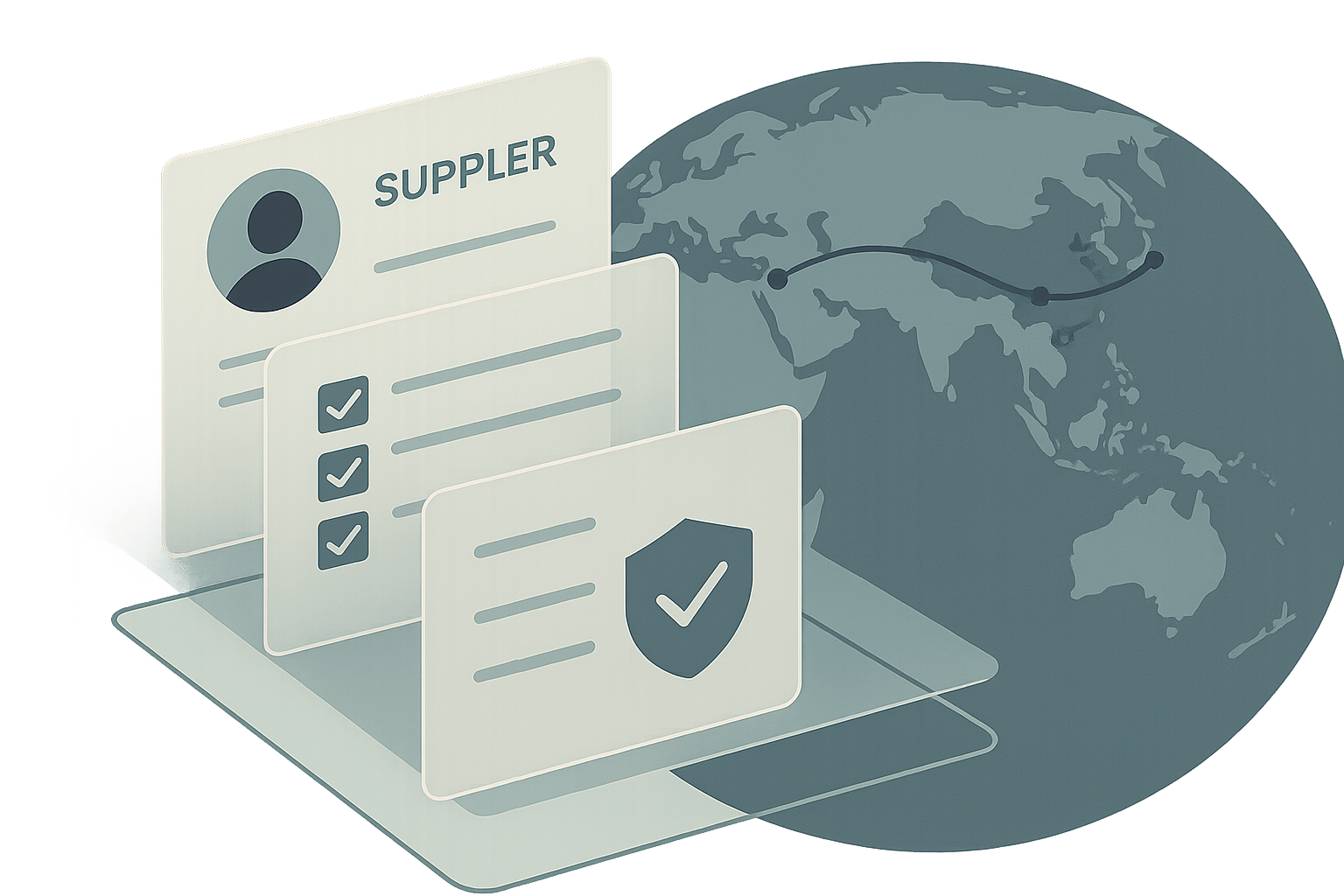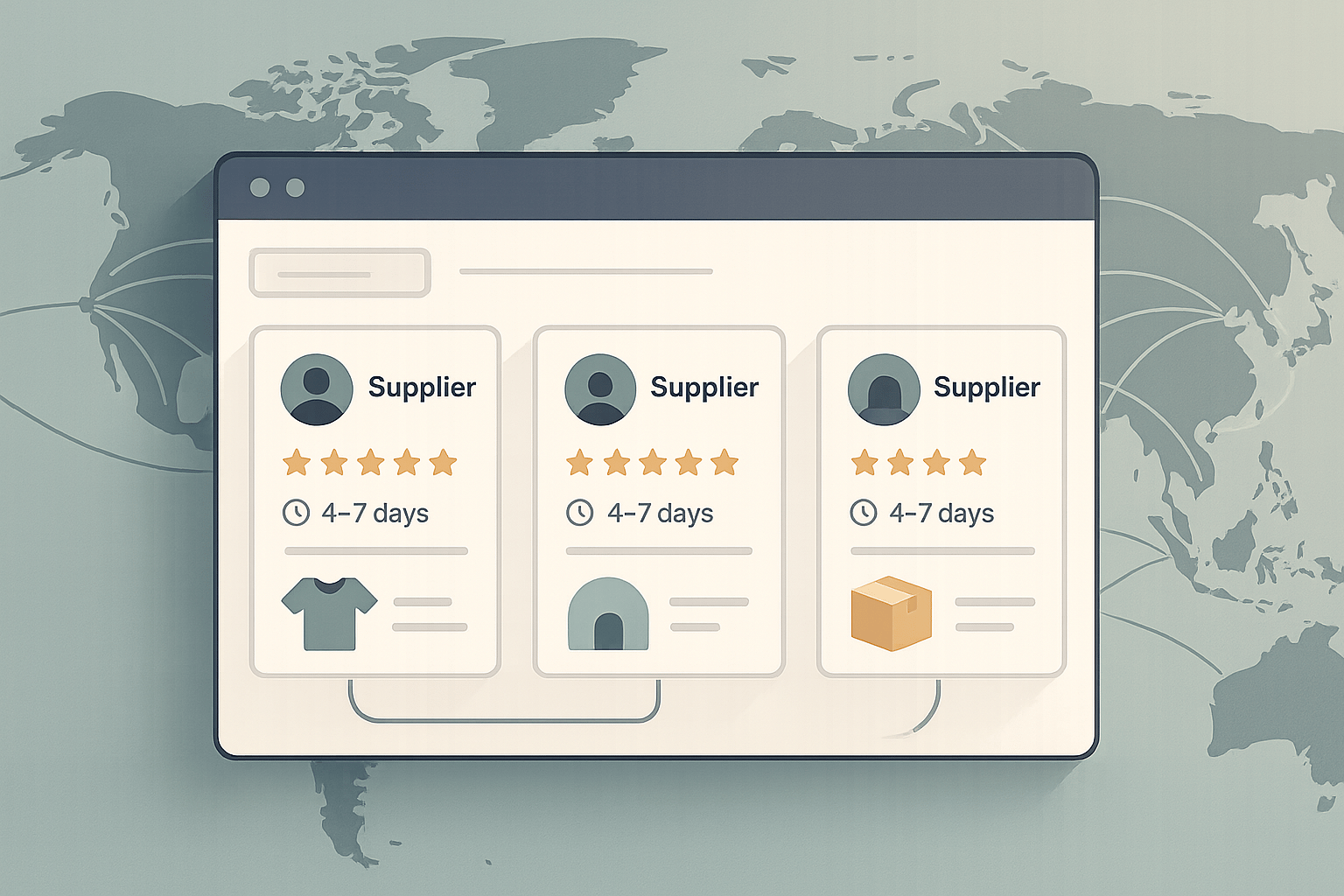Vietnam is cheaper for labor and tariffs, but China excels in automation and supply chain efficiency.
Here’s the breakdown:
- Labor Costs: Vietnam’s wages are 30–50% lower than China’s.
- Tariffs: U.S. tariffs on Chinese goods are at 104%, while Vietnamese goods face only 46%.
- Productivity: China’s automation and advanced infrastructure make it better for high-tech, large-scale production. Vietnam relies more on manual labor, which affects efficiency.
- Materials: China sources 90%+ of materials locally, cutting costs and lead times. Vietnam imports 70%+ of inputs, increasing complexity.
- Lead Times: Vietnam is faster for small-batch production and shipping, with 7–15 days for orders and 30-day shipping to the U.S. (33% faster than China).
- Trade Agreements: Vietnam benefits from deals like CPTPP and EVFTA, reducing costs for non-U.S. markets.
Quick Comparison
| Criteria | China | Vietnam |
|---|---|---|
| Labor Costs | $500–$800/month | $250–$400/month |
| U.S. Tariffs | 104% | 46% |
| Productivity | High (automation) | Lower (manual labor) |
| Material Sourcing | 90%+ local | 70%+ imported |
| Lead Times | 30–60 days (orders) | 7–15 days (orders) |
| Shipping Time | 45 days to U.S. | 30 days to U.S. |
| Trade Agreements | Limited | CPTPP, EVFTA benefits |
For cost efficiency, Vietnam is ideal for labor-intensive industries, while China remains the leader in precision manufacturing. A dual-sourcing strategy - using China for components and Vietnam for final assembly - can balance costs and quality.
Labor Costs and Productivity
Average Labor Costs in 2025
When it comes to wages, Vietnam offers a clear cost advantage over China, especially for unskilled labor. By 2025, unskilled workers in Vietnam earn between $250 and $400 per month (approximately $1.35 per hour). In comparison, their counterparts in China take home $500 to $800 monthly (around $6.68 per hour).
The gap widens further for skilled labor. Skilled workers in Vietnam earn between $400 and $700 per month, while in China, similar positions command $800 to $1,200. For industries like apparel, footwear, and consumer electronics - where labor costs make up a significant portion of expenses - this difference can be a game-changer.
| Country | Hourly Wage (Unskilled) | Monthly Wage (Unskilled) | Monthly Wage (Skilled) | Labor Cost Advantage vs. China |
|---|---|---|---|---|
| Vietnam | $1.35 | $250–$400 | $400–$700 | 30–50% lower |
| China | $6.68 | $500–$800 | $800–$1,200 | Baseline |
While wages are rising in both countries, Vietnam's increases have been more gradual, ensuring its cost advantage remains intact for the foreseeable future. Adding to this, Vietnam boasts one of Southeast Asia's youngest workforces, which ensures a steady supply of labor for years to come. On the other hand, China faces challenges with an aging workforce, which could lead to labor shortages and push wages even higher.
Still, lower wages alone don’t tell the whole story. Productivity plays a crucial role in determining overall labor efficiency.
Worker Productivity and Automation
Though Vietnam offers lower labor costs, China outpaces it significantly in productivity and automation. Chinese factories are often equipped with cutting-edge technology and highly automated production lines. This, combined with a seasoned workforce, gives China a clear edge in handling complex manufacturing operations.
Vietnam’s manufacturing sector, while growing rapidly, still relies heavily on manual labor. This reliance can narrow Vietnam's cost advantage, as lower productivity means more time and resources are needed to achieve the same output.
For industries requiring high-tech or precision manufacturing - where consistency and strict quality standards are critical - China's automation capabilities become indispensable. For instance, companies like Apple continue to depend on Chinese factories for producing complex products with tight tolerances. Vietnam, with its manual processes, struggles to match the consistency offered by China’s automated systems.
Quality control is another area where China excels. Its mature manufacturing ecosystem includes established quality standards and third-party inspection services, reducing the need for additional investments in quality assurance. Vietnam, on the other hand, is still building its quality control infrastructure, which often requires companies to allocate extra resources to ensure product standards are met.
Ultimately, while Vietnam’s cost efficiency is attractive, China's productivity and automation make it the go-to choice for high-precision manufacturing. By strategically combining Vietnam’s lower costs with China’s technological advantages, businesses can strike a balance between affordability and quality.
Is Sourcing from Vietnam REALLY Better than China? (Side by Side comparison)
Material and Component Sourcing
When it comes to sourcing materials and components, China and Vietnam operate in very different ways. The availability and cost of raw materials are critical factors that can shape your sourcing strategy. Let’s take a closer look at how each country’s infrastructure impacts lead times and overall costs.
China's Supply Chain Infrastructure
China’s dominance in manufacturing is largely fueled by its well-established supply chain, which has been refined over decades. This mature system allows manufacturers to source more than 90% of their materials locally, which translates to quicker response times and lower transportation costs. Factories can adapt to design changes or fulfill rush orders in just days, avoiding the delays that come with importing materials. The result? Shorter lead times, fewer logistical headaches, and reduced costs.
This robust supply chain is especially valuable in complex industries like electronics. In these sectors, the entire ecosystem - spanning semiconductors, specialized plastics, and more - is concentrated near major production hubs. This setup supports high-volume production while minimizing risks from shipping delays, currency fluctuations, and unexpected import duties.
Vietnam's Dependence on Imported Inputs
Vietnam, on the other hand, faces a different reality. While its lower labor costs appeal to many brands, its reliance on imported raw materials and components adds complexity. For instance, a textile manufacturer in Vietnam reported that 70% of its raw materials were sourced from China, leading to higher costs and longer lead times. Vietnam’s reliance on imports from countries like South Korea, Japan, and Taiwan further exacerbates these challenges, introducing additional costs such as shipping fees, import tariffs, and the need for extended inventory planning.
These factors can diminish Vietnam’s labor cost advantage. In 2023, a major electronics brand shifted final assembly operations to Vietnam but continued sourcing critical components from China due to the limited availability of local suppliers. While this move saved on labor, it increased logistical complexity and lead times.
That said, Vietnam does offer cost benefits in specific product categories. For example, packaging costs in Vietnam can be up to 25% lower than in China, thanks to reduced labor and material input expenses. The key for brands is figuring out which materials can be sourced locally in Vietnam and which will need to be imported.
| Factor | China | Vietnam | Impact on DTC Brands |
|---|---|---|---|
| Local Material Availability | High (90%+ domestic sourcing) | Low (70%+ imports for many industries) | Faster procurement and lower logistics costs in China |
| Lead Time Impact | Short (days to weeks) | Long (weeks to months) | Quicker product launches with China's supply chain |
| Total Landed Cost | Lower due to local sourcing | Higher due to import dependencies | More cost-effective in China |
Another consideration is quality assurance. Vietnam is still building its quality assurance capabilities, which often requires additional resources to meet product standards. In contrast, China’s established quality assurance processes and third-party inspection services help streamline this aspect, reducing the need for extra investments.
For DTC brands, it’s vital to look at the full picture - labor costs, material sourcing, logistics, and quality assurance. While Vietnam’s lower wages are tempting, the added expenses from imported materials can make China the more cost-effective choice overall.
To simplify the sourcing process, platforms like ForthSource aggregate supplier data and use scoring systems to identify reliable, cost-effective suppliers in both markets. This makes it easier to decide where to source materials and where to handle final assembly - key factors that will influence your overall strategy. These dynamics will also play a role in balancing component sourcing and assembly decisions, which we’ll explore further in the next section.
Tariffs and Trade Agreements
Tariffs and trade agreements play a major role in shaping sourcing costs for U.S.-bound DTC (direct-to-consumer) brands. For businesses importing goods to the U.S., these factors can have a significant impact on profit margins. In 2025, U.S. tariff policies heavily favor Vietnam over China, providing cost advantages that go beyond just labor and materials.
U.S. Tariffs on China and Vietnam in 2025
In 2025, U.S. tariffs are decidedly more favorable for Vietnam compared to China. Chinese imports face a steep total tariff of 104%, while goods from Vietnam are subject to a much lower rate of 46%. These tariffs are a result of ongoing trade tensions and policies introduced during the U.S.-China trade conflict.
The effect of these tariffs varies depending on the product category. For instance, U.S. tariffs on packaging products from China range between 15% and 25%, whereas similar products from Vietnam may only face tariffs between 0% and 10%. To put this into perspective, a $10 product from China ends up costing $20.40 after a $10.40 tariff. By contrast, the same product from Vietnam, even with a slightly higher factory price of $11, would cost just $16.06 after tariffs - making it a much more economical choice. This stark difference influences supplier decisions and overall landed costs.
This tariff disparity has prompted many major brands to shift their operations to Vietnam. Companies like Samsung, Nike, Adidas, LG, and Foxconn have already relocated production from China to Vietnam, citing not only lower tariffs but also reduced labor costs.
Effects of Trade Agreements
Vietnam's participation in several trade agreements further strengthens its appeal as a sourcing destination. The country is a member of the Comprehensive and Progressive Agreement for Trans-Pacific Partnership (CPTPP), the EU-Vietnam Free Trade Agreement (EVFTA), and the Regional Comprehensive Economic Partnership (RCEP). While these agreements don’t directly reduce tariffs on U.S. imports, they provide significant benefits for brands aiming to expand globally. For example:
- The EVFTA will eliminate 99% of EU tariffs on Vietnamese goods by 2027.
- The CPTPP grants duty-free access to key markets like Japan, Canada, and Mexico.
In contrast, China is excluded from these preferential agreements, which limits its access to similar benefits.
| Trade Factor | China | Vietnam | Impact for DTC Brands |
|---|---|---|---|
| U.S. Tariff Rate | 104% | 46% | Vietnam’s rate is 58 percentage points lower. |
| EU Market Access | Standard tariffs | 99% of tariffs eliminated by 2027 | A major cost advantage for EU-bound sales. |
| Asia-Pacific Access | Limited agreements | Duty-free access via CPTPP | Better positioning for regional growth. |
The growing "China Plus One" trend, where companies diversify production to Vietnam, is gaining momentum. This strategy helps mitigate tariff risks and lower costs. For DTC brands, understanding the differences in tariffs and trade agreements is key to calculating total landed costs. Tools like ForthSource allow brands to compare suppliers in real time, helping them find cost-effective and reliable sourcing options.
Vietnam’s combination of lower tariffs and favorable trade agreements makes it a standout choice for brands with global ambitions. However, while the cost advantages are clear, businesses must also weigh factors like production capacity and supply chain infrastructure - topics that will be explored in the next section.
sbb-itb-633367f
Lead Times and Production Capacity
Production capacity plays a crucial role in determining both sourcing costs and how quickly customer orders can be fulfilled. These factors directly impact lead times and the flexibility of orders, as seen in the comparison below.
China's High-Volume, Fast Production
China continues to dominate global manufacturing, owing to its advanced infrastructure and widespread use of automation. Chinese suppliers excel at handling massive orders with consistency and speed. Standard production lead times typically fall between 30 and 60 days, while customized orders take about 5 to 8 weeks to complete.
What sets China apart is its ability to scale. When there's a need to ramp up production quickly or manage very large volumes, Chinese factories are well-equipped with technologies that ensure faster production cycles without compromising quality. This scalability, however, comes with higher minimum order quantity (MOQ) requirements. The emphasis on high-volume, automated production makes China an excellent choice for established brands needing large quantities. On the flip side, this can pose challenges for startups or direct-to-consumer (DTC) brands experimenting with new products.
Vietnam's Small-Batch Production
Vietnam offers a different approach, focusing on agility with smaller, quicker production runs. Standard orders in Vietnam are typically completed in 7 to 15 days, while customized orders take 4 to 6 weeks - significantly faster compared to China's timelines of 30–60 days and 5–8 weeks.
Vietnam's speed advantage is largely due to its flexibility and lower MOQ requirements. Vietnamese manufacturers are more accommodating of smaller orders, making them a great fit for startups, small-to-medium enterprises, and DTC brands producing limited editions. This adaptability is supported by a production model that leans more on manual labor than heavy automation.
Vietnam has also made strides in reducing production downtime. On average, Vietnamese factories experience only 2 days of downtime per quarter, compared to 8 days in China - a 75% improvement. Shipping lead times from Vietnam are also faster, averaging around 30 days, which is roughly 33% quicker than China's 45-day average.
While Vietnam's strengths in speed and flexibility are particularly appealing for labor-intensive industries like apparel, footwear, furniture, and certain consumer goods, its production capacity is best suited for small to medium batch orders. Scaling up to large volumes can be more challenging due to less automation and a smaller supplier network. Additionally, Vietnam's dependence on imported materials can occasionally lead to delays, especially during global supply chain disruptions.
| Production Factor | China | Vietnam | Advantage |
|---|---|---|---|
| Standard Order Lead Time | 30–60 days | 7–15 days | Vietnam by 15–45+ days |
| Custom Order Lead Time | 5–8 weeks | 4–6 weeks | Vietnam by 1–2 weeks |
| Shipping Lead Time | 45 days (avg.) | 30 days (avg.) | Vietnam 33% faster |
| Production Downtime | 8 days/quarter | 2 days/quarter | Vietnam 75% less downtime |
| MOQ Flexibility | Higher | Lower | Vietnam for small batches |
| Scalability | Excellent | Best for small to medium batches | China for high volume |
For DTC brands, the decision between China and Vietnam hinges on specific priorities. Established brands needing high-volume, consistent production will benefit from China's infrastructure and automation. On the other hand, brands seeking flexibility, quicker turnaround times, and lower MOQs may find Vietnam's small-batch production approach more suitable.
For those looking to balance volume with agility, a hybrid strategy can be effective. Using China's high-volume production for components and Vietnam's flexible, small-batch assembly can offer a competitive edge.
Platforms like ForthSource simplify this decision-making process by providing real-time supplier data from both China and Vietnam. With insights into lead times, MOQs, and production capacities, these tools help you quickly identify suppliers that align with your specific needs - saving time and avoiding outdated directories or middlemen.
Dual Sourcing Strategies: Cost and Risk Management
Dual sourcing, which involves splitting production between China and Vietnam, offers a way to cut costs, manage risks, and create more resilient supply chains. With U.S. tariffs currently favoring Vietnam, businesses have even stronger financial reasons to adopt this strategy.
The "China+1" approach takes advantage of what each country does best. China’s advanced automation and extensive supply chain infrastructure make it ideal for certain production processes. Meanwhile, Vietnam’s lower labor costs and favorable trade agreements make it a smart choice for other stages. By combining China’s manufacturing scale with Vietnam’s cost efficiency, companies can streamline their production process.
Combining Component Sourcing and Final Assembly
One of the most effective ways to implement dual sourcing is to source components and raw materials from China and complete final assembly in Vietnam. For example, a direct-to-consumer (DTC) electronics brand might procure printed circuit boards, casings, and other precision components from Shenzhen, then ship these materials to Ho Chi Minh City for final assembly, packaging, and quality control. This setup strikes a balance between China’s precision manufacturing and Vietnam’s cost-effective labor.
A practical example of this strategy is Kenvox, a silicone and plastic molding company. Between 2024 and 2025, Kenvox established operations that sourced raw materials and equipment from China while conducting final assembly in Vietnam. This allowed its U.S. and Canadian clients to sidestep high tariffs on Chinese goods, maintain quality standards, and reduce production delays.
Vietnam’s proximity to China makes cross-border shipping of components relatively quick, typically taking 7–15 days. Industries that rely heavily on labor - such as apparel, footwear, consumer electronics, and furniture - stand to benefit the most. These industries can tap into China’s expertise in precision manufacturing while using Vietnam for cost-effective assembly and packaging. Completing the final assembly in Vietnam also qualifies products for Vietnamese origin status, which can reduce U.S. import duties by as much as 58%. Additionally, trade agreements like the CPTPP and EVFTA improve market access, making this dual sourcing strategy even more appealing.
Using ForthSource for Dual Sourcing

For brands looking to implement dual sourcing efficiently, ForthSource provides a valuable solution. Managing suppliers in two countries has traditionally required significant research and multiple broker relationships. ForthSource simplifies this process by offering a platform with real-time supplier data and comparison tools for both China and Vietnam.
The platform uses a proprietary scoring system to evaluate suppliers based on factors like pricing, credibility, WeChat data, and legal reports. This allows brands to identify reliable component suppliers in China and trustworthy assembly partners in Vietnam using consistent standards.
ForthSource also aggregates data from over 50 supplier platforms, ranking suppliers based on their real-time performance and reliability. To further build trust, it incorporates sentiment signals from sources like Google Reviews, Trustpilot, and public web data. For DTC brands navigating dual sourcing, these insights - along with region-specific confidence signals and global logistics data - are crucial for coordinating shipments and managing cross-border operations effectively.
Conclusion: Key Takeaways for DTC Brands
Choosing between China and Vietnam as a manufacturing hub in 2025 involves weighing factors like labor costs, tariffs, materials, and production capacity. On the surface, Vietnam's factory wages - ranging from $250 to $400 per month - offer a 30–50% savings compared to China's $500–800 monthly wages. But the decision gets more nuanced when you bring tariffs, material expenses, and production capabilities into the equation.
When it comes to tariffs, Vietnam holds a clear advantage. U.S. import duties for Vietnam stand at 46%, significantly lower than China's 104%. This 58-percentage-point difference can help offset other costs, like higher material prices or longer setup times. On the other hand, China's well-established supply chain and automation capabilities often result in lower per-unit costs for large-scale production, despite its higher labor rates.
Production timelines and capacity should also match your business needs. China excels at handling large-scale orders with lead times of 30–60 days. Vietnam, however, is better suited for faster small-batch production, with typical lead times of 7–15 days. For instance, one packaging company saw a 31% reduction in labor costs and a 33% improvement in shipping times after moving production from China to Vietnam. These differences highlight the importance of aligning your sourcing strategy with your operational goals.
A dual-sourcing approach - using China for components and Vietnam for final assembly - can strike a balance between cost efficiency and supply chain resilience.
Platforms like ForthSource simplify this decision-making process. By leveraging a proprietary scoring system and data from over 50 supplier sources, they help brands compare suppliers in China and Vietnam quickly and effectively.
FAQs
How can businesses balance Vietnam's lower costs with China's higher productivity when sourcing in 2025?
To balance Vietnam's cost benefits with China's productivity strengths, businesses should adopt sourcing strategies that rely on data. Platforms like ForthSource make this easier by offering tools to find trustworthy suppliers, compare expenses, and evaluate quality indicators instantly.
Using these tools allows companies to make more informed choices, minimize risks, and select suppliers that meet both financial and operational needs across different regions.
What factors should I consider when choosing between China and Vietnam for sourcing materials and components in 2025?
When weighing the options between sourcing from China or Vietnam, several critical factors come into play:
- Labor costs: Vietnam often boasts lower labor costs compared to China. However, this can differ based on the specific industry and location within each country.
- Material availability: China has a well-established supply chain with broader access to raw materials. Vietnam, while expanding rapidly, may still have fewer options in certain categories.
- Logistics and shipping: China's logistics network is typically more advanced, offering efficient shipping times and infrastructure. That said, Vietnam's location near key Southeast Asian markets can provide a logistical edge for certain businesses.
The best choice ultimately hinges on your product requirements, budget constraints, and overall business priorities. Tools like Forthsource can be a valuable resource to compare suppliers, utilizing real-time data and quality insights to guide your decision-making process.
How do trade agreements and tariffs impact sourcing decisions between China and Vietnam for manufacturing?
Trade agreements and tariffs play a crucial role in shaping the overall cost of manufacturing in China or Vietnam. These factors can directly influence how affordable it is to import goods, making one country more appealing than the other for specific products.
Take Vietnam, for instance. It enjoys trade deals like the Comprehensive and Progressive Agreement for Trans-Pacific Partnership (CPTPP) and its Free Trade Agreement with the European Union. These agreements help lower tariffs and improve access to international markets. On the other hand, China’s extensive manufacturing infrastructure often compensates for its higher tariffs, thanks to its unmatched efficiency and production scale.
For businesses deciding between these two options, it's critical to analyze how trade policies affect total landed costs - including tariffs, duties, and compliance expenses. This thorough evaluation ensures decisions are grounded in a clear understanding of all associated costs.


